The Dolomites, a UNESCO World Heritage Site, had been on my bucket list for years. I’d seen countless photos of its jagged peaks, turquoise lakes, and charming alpine villages, and I couldn’t wait to experience it myself.
Let me tell you—those photos don’t even come close to capturing how stunning this place truly is.


What’s unique about the Dolomites is how it feels like stepping into another world. Even though it’s in Italy, you’ll hear German being spoken, see signs written in German, and enjoy hearty Austrian-inspired meals. It’s a fascinating blend of cultures that makes exploring this region even more magical.

When I planned my Dolomites road trip, I had sky-high expectations—probably too high! But guess what? Every single one of them was surpassed. From dramatic mountain passes to picturesque lakes, this destination is pure perfection.

In this post, I’m sharing the best Dolomites itinerary for an unforgettable adventure. This detailed Dolomites 4-day itinerary includes everything you need to know: must-visit spots, tips for driving, where to stay, and even a free map to help you plan.
Whether you’re still deciding or your trip is already booked, this guide will help you make the most of your time in one of the most breathtaking places on Earth. Keep reading, and let’s plan your dream Dolomites road trip together!
What is the best time of year for visiting the Dolomites?
The Dolomites are a breathtaking mountainous region, well-known for their heavy snowfall. Just glance at a map, and you’ll spot dozens of ski lifts and chairlifts scattered across the area.
It’s a paradise for snow sports enthusiasts, so if skiing or snowboarding is your goal, planning a trip to the Dolomites during the peak of winter is a must. That’s when the slopes are at their best, blanketed in pristine snow.


That said, this Dolomites itinerary is all about a different kind of adventure. One that focuses on exploring the region’s natural beauty through scenic drives, stunning hikes, and charming villages. My Dolomites road trip took place in late May. While rain was forecast every day, it only rained on the first day of my trip!


If hiking is what you’re after, the best time to follow this Dolomites guide is between August and early October. That’s when most trails are free from snow, offering clear and safe paths.
However, keep in mind that even in July, some higher-altitude trails can still have lingering snow. I learned this the hard way and couldn’t explore everything I’d planned due to unexpected snow. So, plan wisely and pack accordingly to make the most of your Dolomites road trip!
How many days do you need to visit the Dolomites?
The ideal length for the perfect Dolomites itinerary depends on how much you want to explore. This region is packed with incredible sights and activities.
For my trip, I chose to spend 4 days in the Dolomites, and I think it was the perfect introduction to this stunning destination.
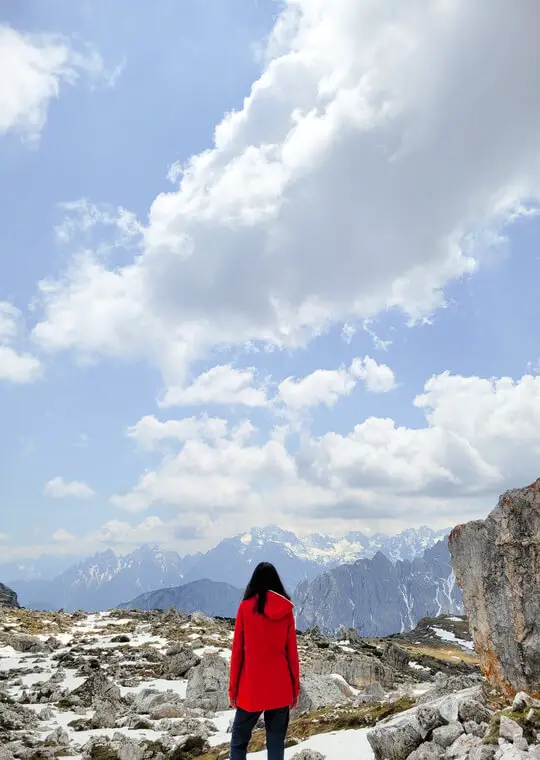

In just 4 days, I managed to see some of the best things to do in the Dolomites. This includes visiting iconic lakes, experiencing one of Europe’s largest plateaus, and soaking in breathtaking views around every corner. It was a packed but rewarding adventure! 😍


That said, there’s so much more to explore. If you have extra time, I highly recommend extending your Dolomites itinerary. At the end of this post, I’ll share additional ideas for those lucky enough to have more than 4 days to spend in this magical region.
How to get to the Dolomites?
Being located in Northern Italy, one of the fastest ways to reach the Dolomites is through Verona airport. Alternatively, you can fly into Venice or Treviso airports or even Milan. However, if you’re considering Milan, bear in mind that the journey to the Dolomites will be significantly longer.


When planning your trip, it’s important to consider which part of the Dolomites you’ll be exploring. Nevertheless, this Dolomites itinerary includes some of the best-known places that are all conveniently accessible from Verona Airport.
I recommend checking available flights to Northern Italy and adapting this itinerary to suit your arrival airport.


Another option is to fly to Innsbruck airport in Austria. While it’s close to the Dolomites, renting a car here often comes with additional charges for crossing the border into Italy. Be sure to carefully review the car rental conditions before booking to avoid surprises.
How to get around in the Dolomites?
This 4-day Dolomites itinerary assumes you’ll be renting a car. This is undoubtedly the easiest and most convenient way to visit the region.
In my case, I chose to rent the car with an Italian company – Noleggiare. Noleggiare has service available in any of the 3 strategic airports to access the Dolomites (Verona, Milan and Venice).

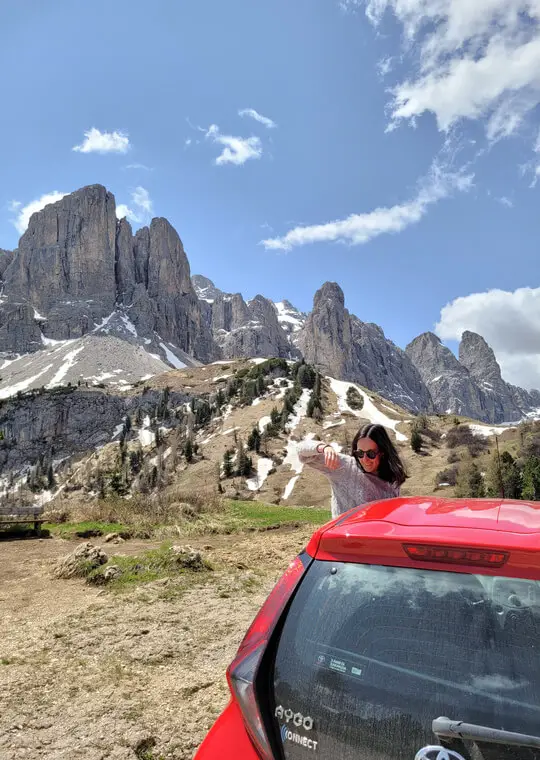
After landing in Verona, I headed to the meeting point where a shuttle took me to the Noleggiare offices near Verona airport. The trip took about 5 minutes. We took all-risk insurance (I never take chances when driving abroad!) and rented a Toyota Aygo. It’s tiny but perfect for two people 😉.
🚗 If you’re renting a car in Italy, Discover Cars is a great platform to compare prices across different rental companies. It offers free cancellation for flexibility, an easy-to-use search tool to find the best deals, and side-by-side comparisons to ensure you get the lowest rates.
Even if you’re planning to explore other cities nearby (like Milan, Verona or Venice), you can rent a car just for this part of your trip. If possible, return the car to the same location where you picked it up to avoid additional fees.
While having a car is definitely the easiest way to explore the Dolomites, it’s not the only option. The region has a public transport system; if you prefer not to drive, you can purchase the South Tyrol Mobilcard. This card gives you access to buses, trains, and cable cars throughout the region, making it a great alternative for getting around.
The South Tyrol Mobilcard comes in several options:
- 1 day – 20€
- 3 days – 30€
- 7 days – 45€
Best accommodation in the Dolomites
The Dolomites offer a variety of accommodation options, from luxury hotels to cosy mountain huts. The best place to stay often depends on your itinerary and the areas you want to explore.
For central access to major attractions, towns like Cortina d’Ampezzo, Ortisei, and Bolzano are popular choices, offering a mix of convenience and charm.

For adventurers planning hikes, rifugios (mountain huts) are a unique option. These lodges are scattered along hiking trails and provide a rustic yet comfortable base for exploring the peaks. They often include meals, making them ideal for multi-day hikes.
No matter where you choose to stay, booking in advance is crucial, especially during peak seasons like summer and winter.
When I visited the Dolomites, I stayed at 3 different places:
- Fiè allo Sciliar
- Lake Antorno
- Braies
In Fiè allo Sciliar, I stayed at Pension Fellis – a truly lovely family-run accommodation. The accommodation has a few rooms available and some have balconies with incredible views.


The location where Pension Fellis is situated is breathtakingly quiet. The room I stayed in was quite spacious and very comfortable. In addition, there are several parking spaces, perfect for those who are doing a Dolomites road trip.

Finally, I must also mention breakfast. The breakfast room has an unbelievable view and is a great way to start the day. In addition, the breakfast had plenty of variety and even some homemade products. For example, the jams were very tasty.
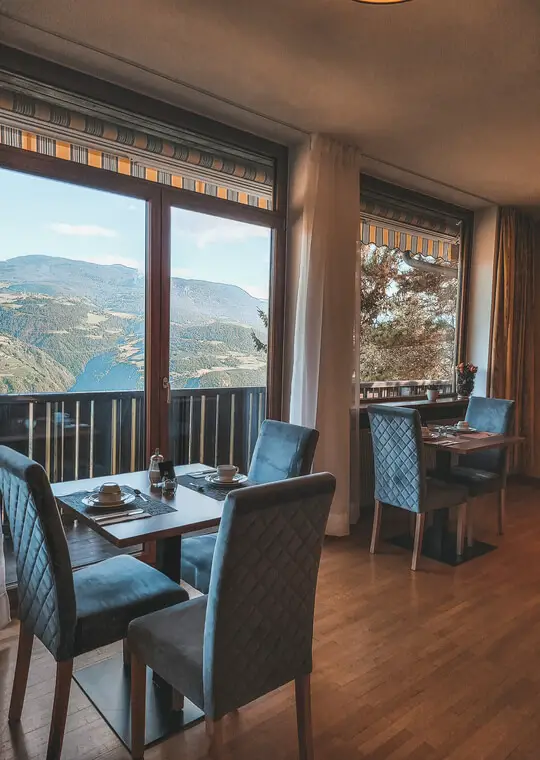

In Lake Antorno, stayed at Chalet Lago Antorno, right in front of the lake. It is a relatively small but wonderful accommodation. The room we got had a balcony with a superb view of the lake, making it a perfect choice for those seeking tranquillity.


The conditions of the accommodation far exceeded my expectations, with a relatively modern and simple decor. In addition, the buffet breakfast had some variety and was included in the price of the stay.

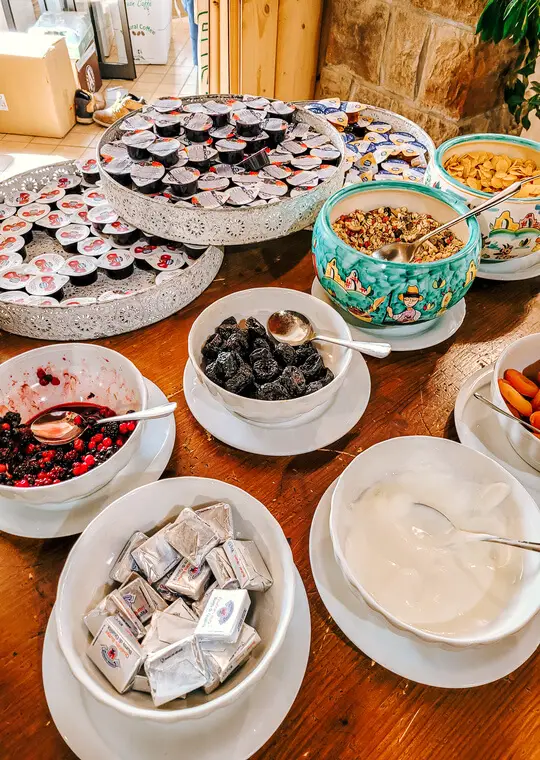
Finally, in Braies, I stayed at Gasthof Huber. Despite the slightly old-fashioned decor, it is only a 10-minute drive from Lake Braies. Plus, it has incredible views from its balconies and a very complete breakfast.

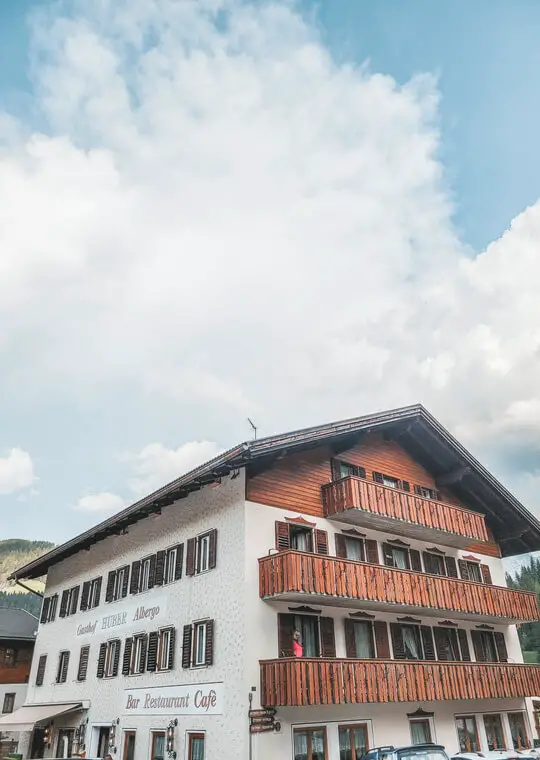

💼 TRAVEL INSURANCE: Unexpected events happen anywhere in the world, so I always recommend getting travel insurance. I regularly use Heymondo, which offers some of the highest coverages on the market at very competitive prices. As well as covering medical expenses, Heymondo’s insurance also covers the loss or theft of luggage, electronic equipment and more. They also have a 24/7 customer service through their App. As A Ticket to Take Off reader, you get a 5% discount when purchasing Heymondo insurance. The purchase must be made using this link, and the price shown on the website already includes the discount.
Dolomites 4-Day Itinerary
Every single day in the Dolomites brought a new surprise. This region is, without a doubt, one of the most beautiful places I’ve ever visited, and I’m already dreaming of coming back to explore the spots I missed 😊.
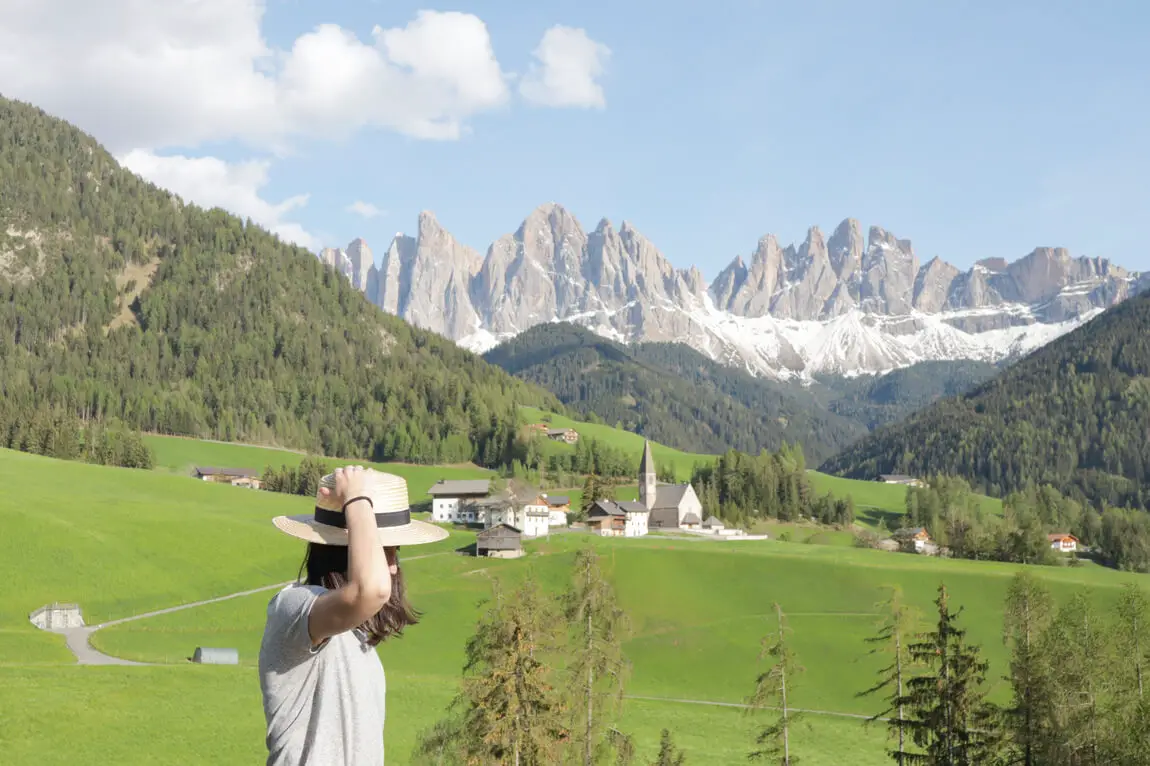
This Dolomites road trip itinerary is designed to cover some of the best places in the Dolomites, from breathtaking lakes to iconic mountain passes. It’s the perfect Dolomites itinerary for those visiting for the first time.
To make your adventure even easier, I’ve included a Dolomites road trip map, which you can check out below. It’ll help you navigate and plan your journey to ensure you don’t miss any of the must-visit highlights in this stunning region!
Day 1: Verona – Bolzano – Lake Carezza – Ortisei – Fiè allo Sciliar (212 km; 3h)
This first day of this Dolomites itinerary begins with the journey from Verona to the first stop in the Dolomites. While it’s the longest drive of the trip, it’s still very manageable—and the stunning scenery along the way more than makes up for it. Honestly, I was amazed by the landscape right from the start! 😊


We opted to take the most direct route, without avoiding toll roads, which made the drive smooth and efficient.
The tolls (round trip) were 24€. The process was super simple: we passed through a toll gate, took a ticket, and paid later at another gate, either by cash or card.
You might be coming from another airport, so the journey could be different.
» Bolzano
Bolzano is an excellent gateway to the Dolomites. It is a lovely small town with a colourful central square, full of terraces and streets full of life due to the markets that exist there.

You can stroll around a bit through its streets, but these are Bolzano’s main points of interest:
- Walther Square
- Bolzano’s Cathedral
- Dominican Church
- Obstmarkt (where the street market is held)
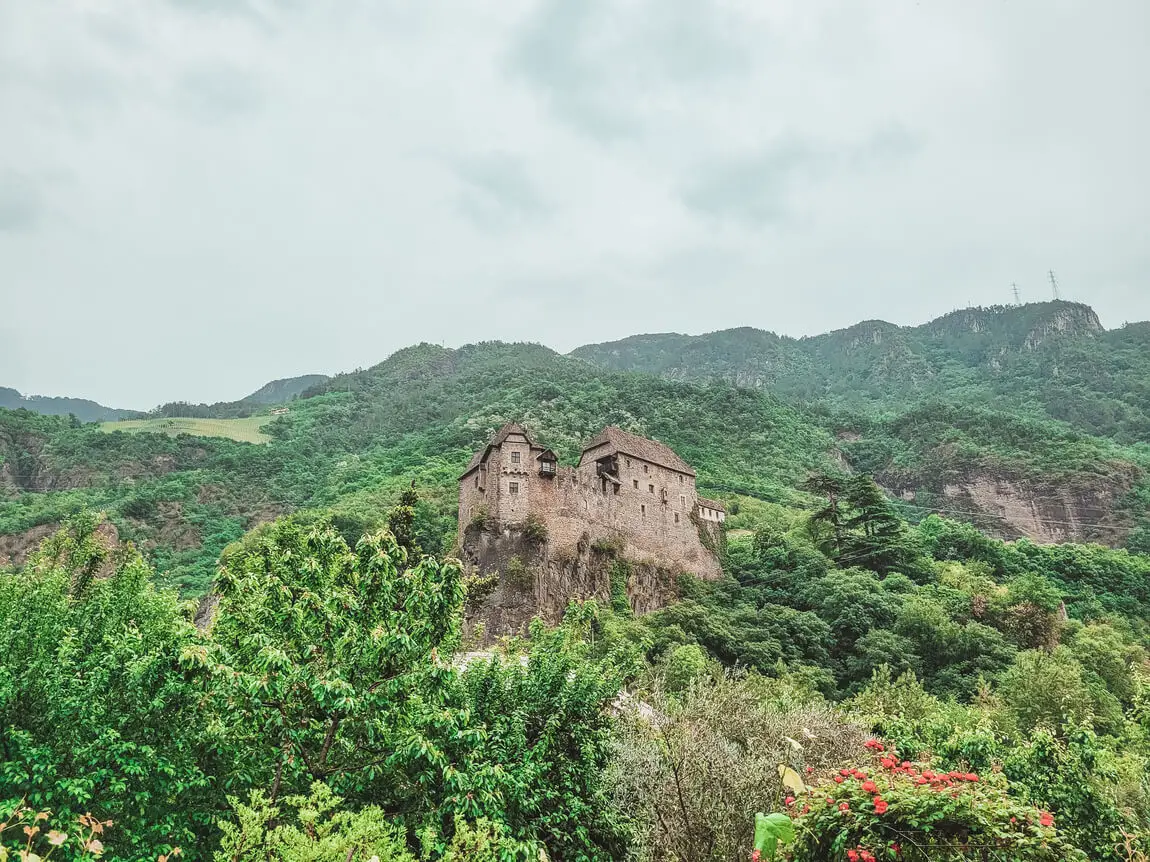
After a short stroll through the centre of Bolzano, you can also take a trip (by car!) to the incredible Roncollo castle. Built on a cliff, this 13th-century work of architecture looks like something out of a fairy tale.
💡 EXTRA TIP: If you have some extra time in Bolzano, I also suggest the Renon cable car that takes you from Bolzano to the Soprabolzano plateau. Although I haven’t tried it, from the photos I’ve seen it seems that from the top we get incredible views of the Dolomites.

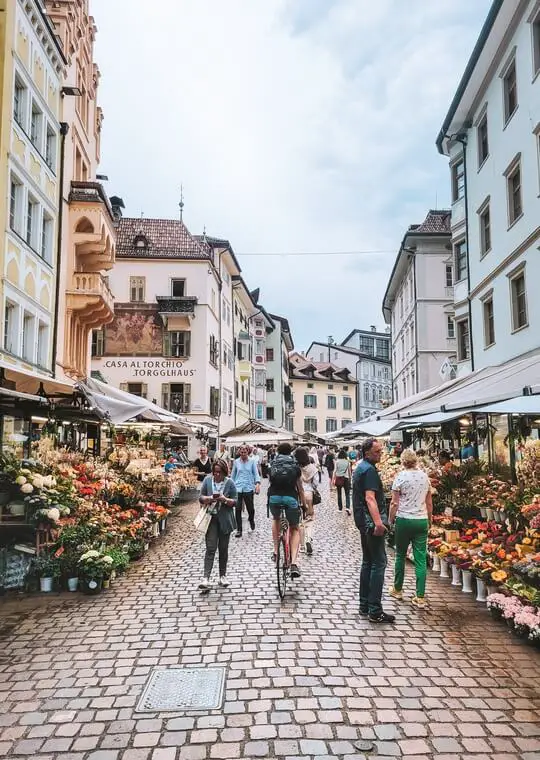
🚗 WHERE TO PARK IN BOLZANO: The historic centre of Bolzano is pedestrian, with a few exceptions for locals and delivery services. There are several car parks available in the city (paid), but I ended up finding a place at this parking.
» Carezza Lake
The second stop on this Dolomites itinerary is Carezza Lake. This was one of the lakes I most wanted to visit because of the incredibly crystal clear colour of the water.
However, it was raining quite heavily when we arrived at the lake and it was not possible to enjoy the space much nor admire the lake in its full splendour.


Even so, you could tell the colour of the water was incredible. On sunny days, this can really be one of the most incredible lakes in the Dolomites.
In addition to visiting the lake, you can walk a short trail around the lake that takes about 20-25 minutes to follow.
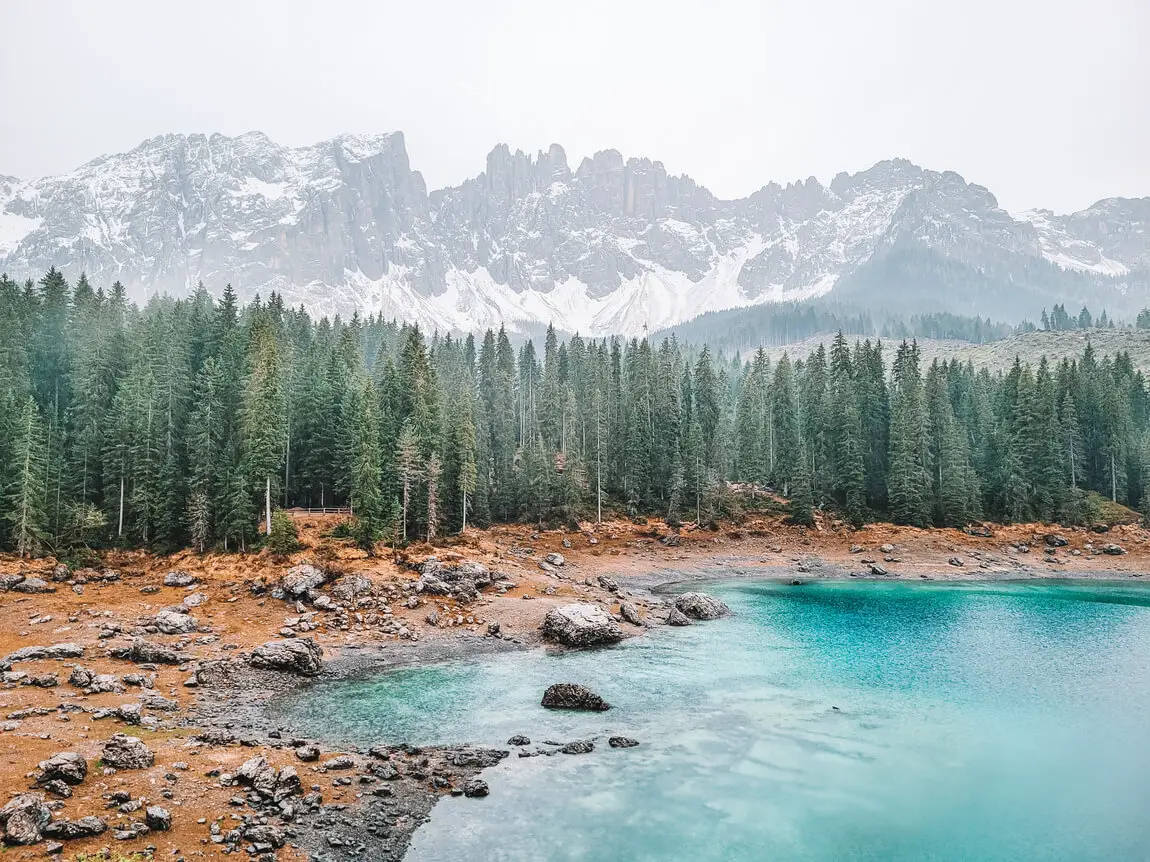
Access to the lake is quite simple and you don’t have to walk along any trails to get there.
🚗 WHERE TO PARK TO VISIT LAKE CAREZZA: There is a car park right next to the lake and it costs 2€ per hour.
» Ortisei
And to finish this first day of this Dolomites itinerary, I suggest a stop in Ortisei. Ortisei is another cute village of colourful tiny houses, surrounded by the majestic mountains of the Dolomites.
It is a well-sought-after destination for tourists visiting the region, so expect crowds during the day in high season. As I visited Ortisei in the low season and at the end of the day, I almost had the village to myself.
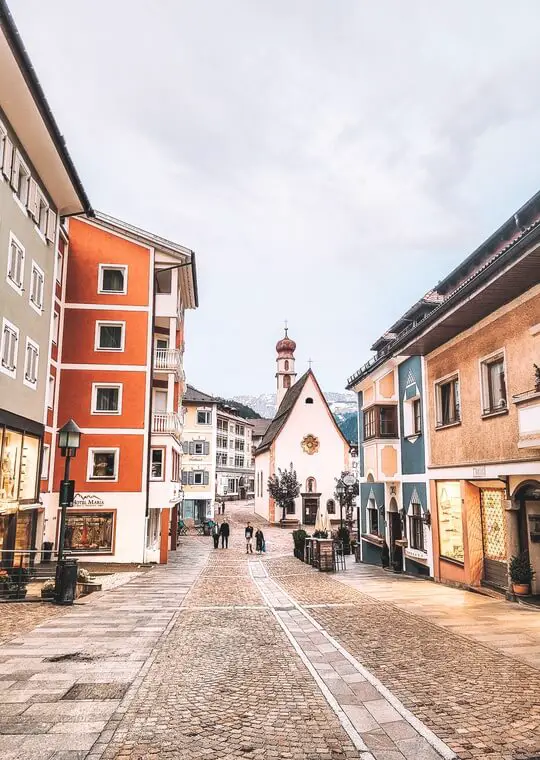
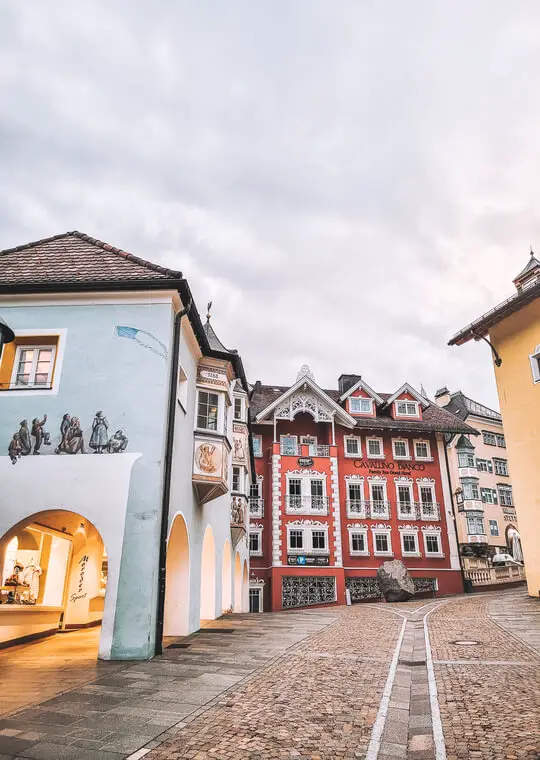
Quite honestly there isn’t much to see, other than the pedestrian area between the chapel of Saint Ulrich and the chapel of Saint Anthony. In between, you will find a few restaurants, accommodations and small shops selling handicrafts and souvenirs (almost all closed when I visited!).
Don’t miss this village, even if the stores are closed. Although it’s small, it’s worth it.
🚗 WHERE TO PARK IN ORTISEI: There are some parking spaces (paid during the day) on the streets of Ortisei, before entering the pedestrian zone. However, during high season, I doubt it will be easy to find a parking space. Therefore, I believe that the best thing to do is use the paid parking spaces available.
Restaurants in Ortisei
By the time I visited Ortisei it was almost dinner time and I opted to stay there. Problem with travelling in the low season? We went to the only open restaurant – Cascade Ristorante Pizzeria. Although it wasn’t the best restaurant on the trip, I enjoyed it. The menu is quite diverse and for all price points. We ended up opting for the pizzas, which were tasty 😉.
Day 2: Fiè allo Sciliar – Alpe di Siusi – Siusi allo Sciliar – Castelrotto – Val di Funes – Fiè allo Sciliar (104 km)
» Alpe di Siusi
Day 2 of this Dolomites 4-day itinerary starts at one of my favourite places on this road trip 🥰.
Alpe di Siusi (or Seiser Alm in German) is a plateau and the largest alpine meadow in Europe. Get ready to think you’re in a Heidi movie.
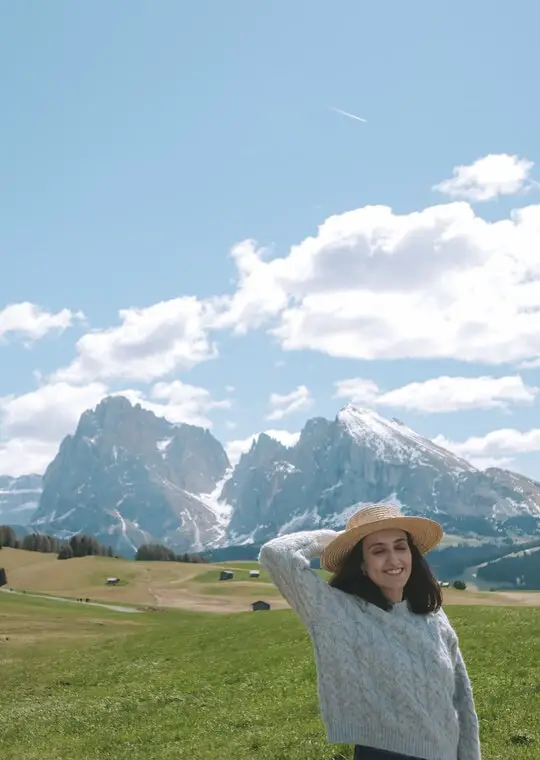

In low season, the road to get around the Alpe de Siusi is open. However, the beauty of the Alpe de Siusi is in letting yourself get lost on those green paths.

In high season, the road is closed from 9 am to 5 pm, although it is possible to go down at any time. So, I suggest you try to arrive before 9 am and park the car in Compatsch. As I went in low season, I drove up to Compatsch after 9 am and still had parking spaces available in this park.
📝 USEFUL INFORMATION: The park at Compatcsh costs 28.5€ for the entire day. Check out the latest information about the parking for Alpe di Siusi.
There is also a cable car that takes you from Siusi allo Sciliar to Compatsch. It is possible to leave the car next to the station of Siusi allo Sciliar in a free car park. The trip lasts 15 minutes and the price varies depending on the time of year but is around 19.5€ (one way) and 29€ (return).
The cable car does not run all year round so I recommend you check the most up-to-date information on the cable car to Alpe di Siusi. Alternatively, you can also take a cable car from Ortisei.
There is also a bus service to Alpe di Siusi.
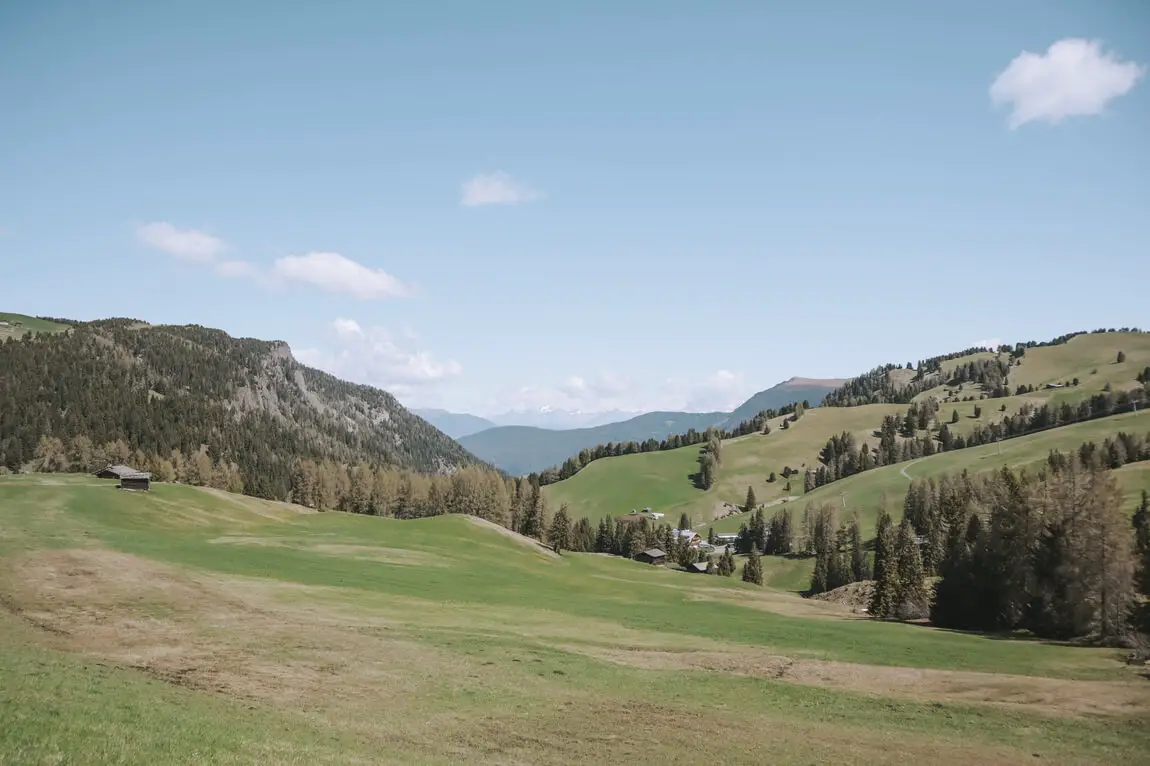
After leaving the car behind, walk to the famous viewpoint of the Alpe di Siusi. From the car park, it takes about 50 min to get there (3,7 km).
Although the viewpoint gives some of the most beautiful photos of the Alpe di Siusi, the whole way there is ridiculously beautiful. I felt like a child, almost wanting to roll around in the grass 😝.
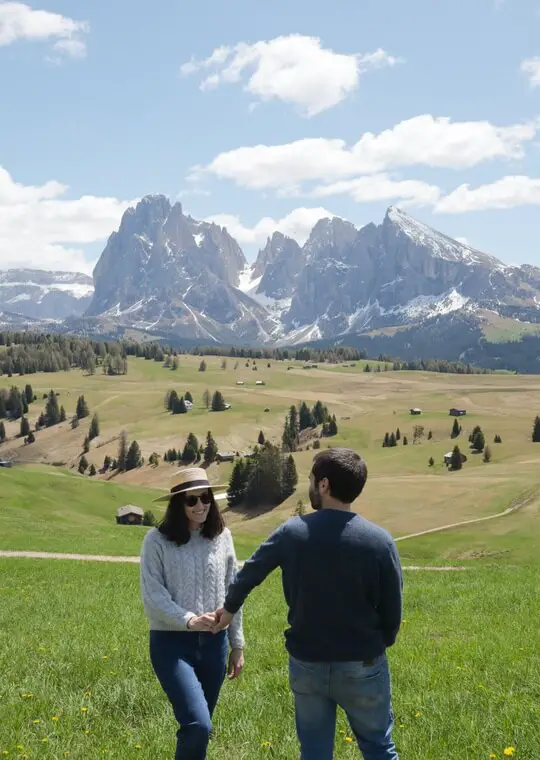
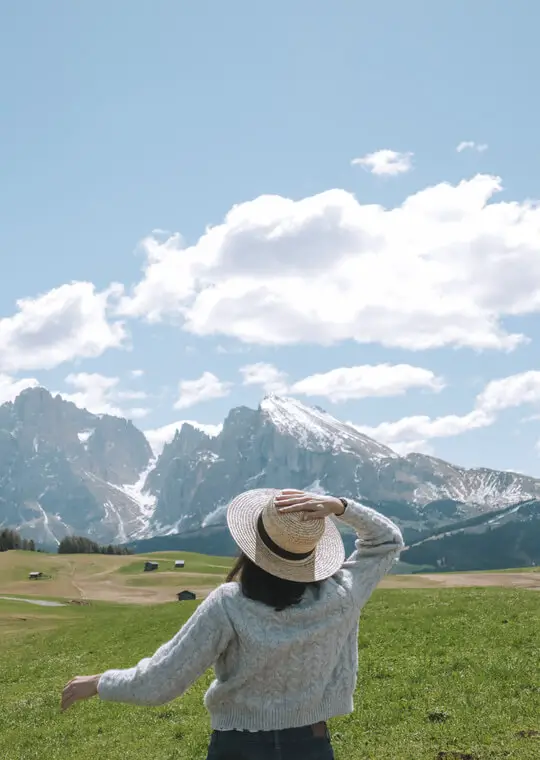
If you wish, you can also visit the Instagrammable swing that is located next to the Malga Sanon refuge. It’s a short diversion and it’s quite a funny ride!


In total, I walked around 10km and spent just one morning exploring Alpe di Siusi. However, the landscapes are absolutely breathtaking, and the area is filled with dozens of trails waiting to be discovered.
If you’re a nature enthusiast, I highly recommend doing some research to find the trail that best suits your interests and fitness level. One thing’s for sure: no matter which path you choose, you won’t be disappointed!
» Siusi allo Sciliar
After exploring Alpe di Siusi, you’ll probably have worked up quite an appetite! Grab some lunch to refuel, and then make a quick stop in Siusi allo Sciliar. This quaint village, home to just 2,000 inhabitants, has a quiet charm that’s perfect for a brief visit.
With a short list of points of interest, you’ll only need about an hour to take in the highlights before continuing your Dolomites 4-day itinerary. It’s a lovely little pause in your adventure!
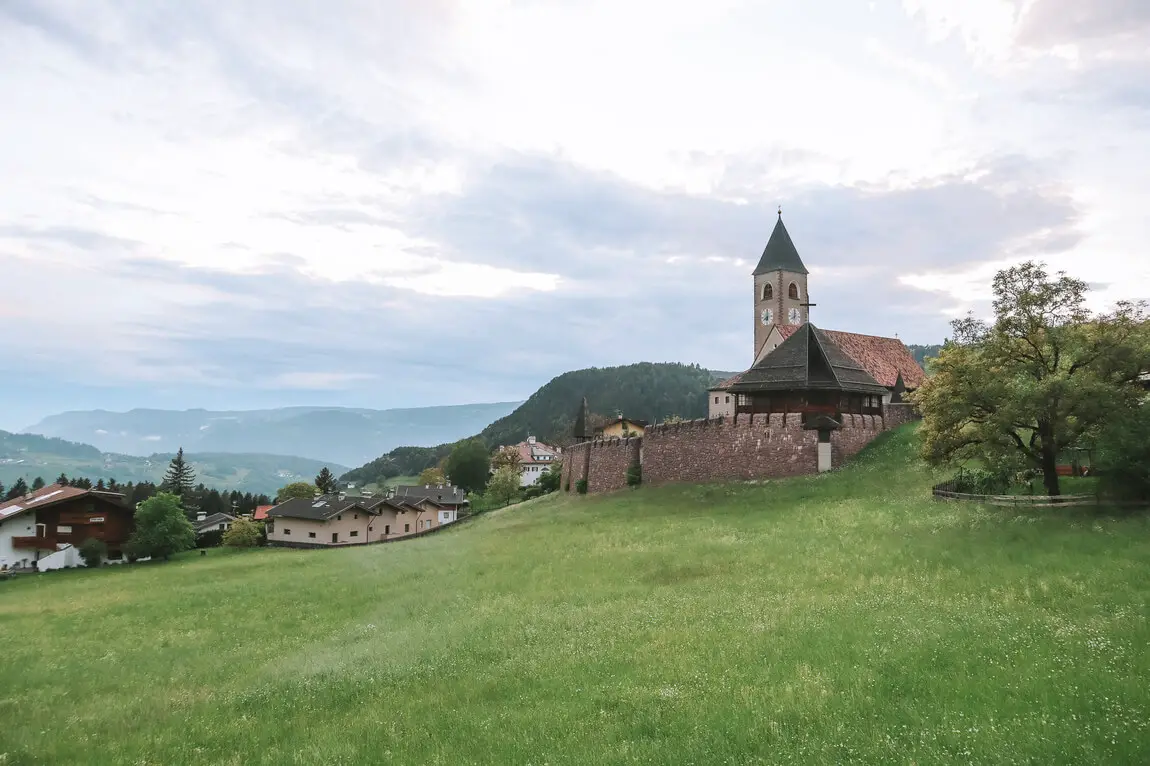
» Castelrotto
The next stop on this Dolomites itinerary is Castelrotto, a charming village that, in my opinion, is even more captivating than Siusi allo Sciliar.
While it’s also a small village with limited sights—its main highlight being the church—the colourful houses and picturesque narrow streets have quite some of that Italian charm.
Strolling through Castelrotto is a delightful experience that will make you fall in love with this enchanting region all over again. It’s the perfect place to soak up the tranquil beauty of the Dolomites!

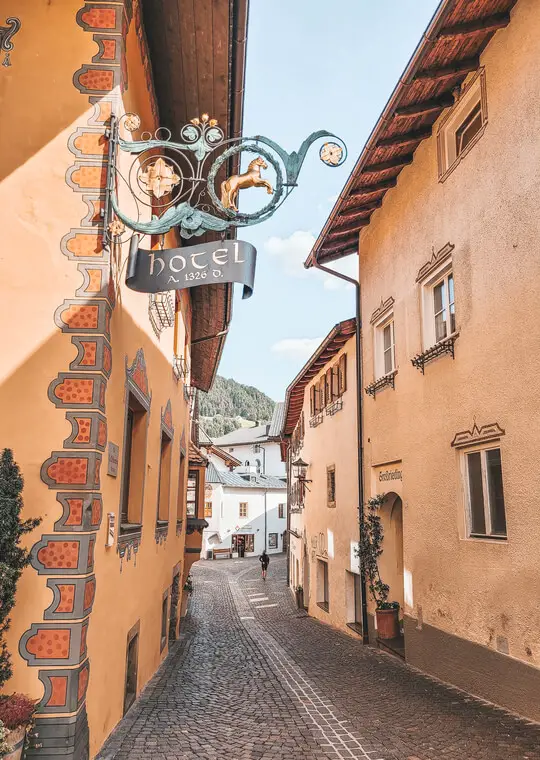
» Val di Funes (St. Magdalena)
As if the superb views of the Alpe di Siusi weren’t good enough, wait until you get to Val di Funes.
Park your car for free at this parking and walk for about 25 minutes to the famous viewpoint over the church of Santa Magdalena. Keep in mind that driving up to the viewpoint is not an option, as the road is closed to vehicles.

The path to the viewpoint is a pleasant walk, even though it’s mostly uphill. Along the way, you’ll be treated to beautiful surroundings that make the climb enjoyable.
Once at the top, you’ll find a bench where you can rest and soak in the breathtaking view of the church of Santa Magdalena and the stunning backdrop. It’s a peaceful spot to pause, recharge, and fully appreciate the magic of the Dolomites!
💡 EXTRA TIP: Relatively nearby, you can also visit the charming Church of Saint John in Ranui. This is a picturesque spot surrounded by lush meadows and dramatic mountain peaks. To get closer and access the interior, there’s a small fee of 4€. However, I opted to observe it only from afar as at that time it was no longer possible to visit.

» Fiè allo Sciliar
And to finish the day, explore Fiè allo Sciliar. This is the village where I was staying which wasn’t even in my initial plans. The village is as small or smaller than Siusi allo Sciliar or Castelrotto, but it was impossible to resist it.

Restaurants in Fiè allo Sciliar
While in Fiè allo Sciliar, I had the chance to try a lovely spot called Alpin Roof Flora. The menu is impressively varied, offering everything from burgers to pasta and meat dishes. We decided to go for two pasta dishes, and they were quite good!
The restaurant also features an outdoor terrace, which is perfect for enjoying a meal on warmer days.


Day 3: Fiè allo Sciliar – Gardena Pass – Lake Valparola – Cortina d’Ampezzo – Lake Misurina – Lake Antorno (113 km)
» Passo Gardena
On day 3 of this Dolomites itinerary, I suggest switching accommodation as you’ll be heading further east into the region.
The first stop is the Gardena Pass, one of the most iconic roads in the Dolomites. Situated at an altitude of over 2,000 metres, it offers jaw-dropping views of the surrounding peaks and valleys.

The Gardena Pass connects Val Gardena to Val Badia and is undoubtedly one of the most unforgettable experiences in the Dolomites.
I parked the car near Rifugio Frara, a convenient spot to take in the breathtaking scenery. From there, I took some time to explore the surrounding area, soaking up the stunning landscapes.
» Lake Valparola
If you’re craving more stunning lakes, the third day of this Dolomites itinerary is sure to impress. Your first stop is Lake Valparola, a peaceful and picturesque gem nestled among dramatic mountain peaks.
It’s the perfect way to start a day filled with some of the best lakes in the Dolomites!

At Lake Valparola, you’ll find a convenient spot to park your car for free at Rifugio Passo Valparola. From the parking area, you’ll already have a lovely view of the lake, but for an even better experience, it’s worth taking a short 5-minute walk to get closer.
The easy stroll brings you right to the edge of the lake, where you can fully enjoy its serene beauty and the surrounding mountain scenery.
💡 EXTRA TIP: Depending on the time of year you visit the Dolomites, also stop at Lake Limides. You can park your car next to Rifugio Col Gallina and from there you need to walk about 20 minutes to the lake. Unfortunately, when I visited there was a lot of snow at the very beginning of the trail and I wasn’t able to visit the lake.
» Cortina d’Ampezzo
When it’s time for lunch, head to Cortina d’Ampezzo, one of the most famous towns in the Dolomites.
Known for its alpine charm, Cortina offers a picturesque historic centre with vibrant, colourful houses and a few quaint streets to explore. While strolling through the centre, you’ll also notice plenty of high-end shops.
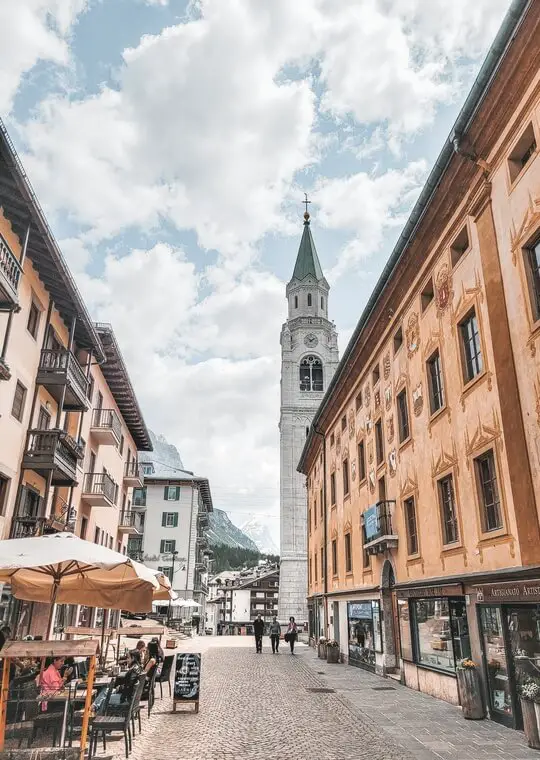

To be very honest, I found the streets photogenic, but it wasn’t one of my favourite places on this road trip. That said, it’s still worth a stop to explore the historic centre, take some great photos, and enjoy the unique charm of this famous alpine town.
Restaurants in Cortina d’Ampezzo
For the first time in a few days, we felt like we were really in Italy and had pizza for lunch at Porto Rotondo. This restaurant offers a lovely terrace and an extensive menu with an overwhelming variety of pizzas to choose from. Deciding on just one might be the hardest part!
While the pizzas are delicious and well-prepared, be prepared for slightly higher prices than usual. Still, it’s a tasty way to enjoy a classic Italian meal in the heart of the Dolomites.
💡 EXTRA TIP: If you are following this Dolomites itinerary make sure to take a short break before reaching Cortina d’Ampezzo to enjoy the stunning view from Gallery Lookout.
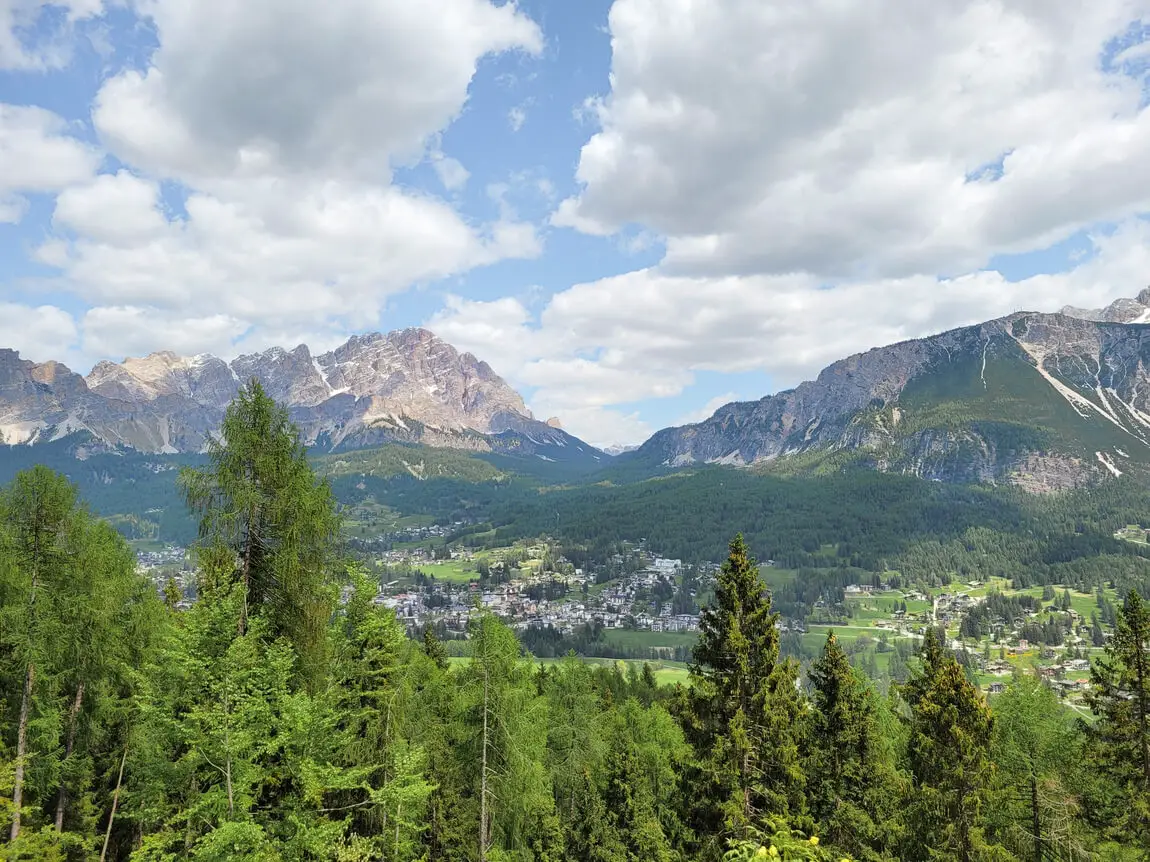
» Lake Ghedina
Leaving Cortina d’Ampezzo, head to the next highlight of this Dolomites itinerary: Lake Ghedina. A quick search for “Lake Ghedina” on Google Maps will get you there, but here’s a pro tip to save you some effort!
When I visited, the road I followed was closed, and I ended up walking nearly 2 km uphill to reach the lake. However, I later discovered that there’s an accessible road on the other side where you can drive directly to the lake. So, be sure to take that route to avoid the hike. 😉

Once you arrive, you’ll be greeted by the lake’s stunning colour and peaceful surroundings. There’s also a charming restaurant on-site, open at certain times of the year, where you can relax and enjoy the serene atmosphere. It’s a beautiful spot that’s definitely worth adding to your Dolomites road trip.
» Lake Misurina
The itinerary through the Dolomites continues to another… lake, surprise surprise! Lake Misurina is very easy to reach, as there are several parking spaces next to the lake.
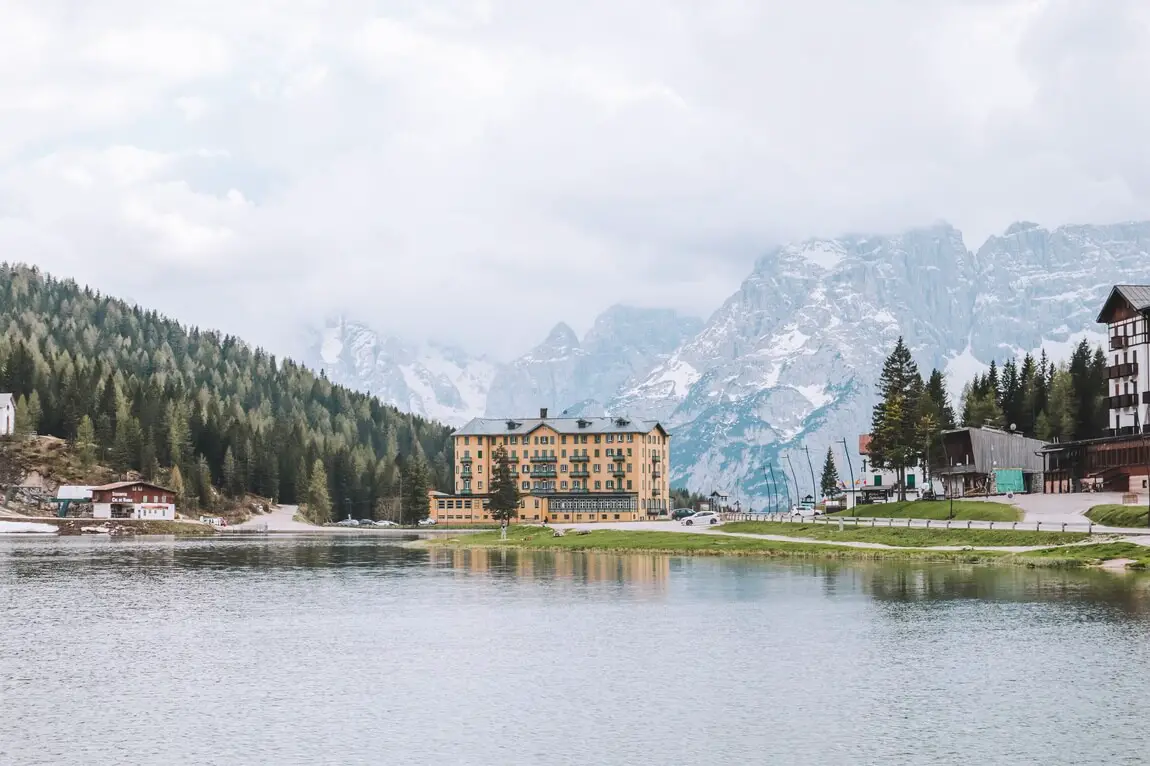
The lake is enviably framed by the mountains and the yellow hotel in the background. It was quite overcast when I visited, which brought some mysticism to this visit.
There is also a small walkway by the lake if you want to spend some extra time there.
» Lake Antorno
The day ended at yet another lake – Lake Antorno and our accommodation was right there (Chalet Lago Antorno)! There are some parking spaces next to the lake, so you certainly won’t have any trouble finding a spot.

The lake is right there by the road, with all its natural beauty. If you’d like to explore further, there’s a small path that circles the lake, perfect for a leisurely stroll and taking in the tranquil surroundings.😊
Day 4: Lake Antorno – Tre Cime di Lavaredo – Lake Landro – Lake Dobbiaco – Lake Braies (48 km)
» Tre Cime di Lavaredo
For this day of your Dolomites itinerary, consider walking one of the most iconic trails in the region that leads to a breathtaking view of Tre Cime di Lavaredo. This is one of the Dolomites’ most famous landmarks.
The trail begins at Rifugio Auronzo and covers approximately 10km for the round trip, offering stunning scenery every step of the way. It’s a must-do for nature lovers and those looking to experience the best of the Dolomites!
But be aware of the snow because you might not be able to do the trail. Keep reading to check out what happened to me.

There are 3 options to get to Rifugio Auronzo:
- By car: if you choose this option, you have to pay 30€ to drive on the road which is private (the fee only gives you access for 24 hours). There is a toll road shortly after Lake Antorno. The price varies depending on the type of vehicle and even bicycles pay. If you choose this option, go early because in high season the car parks at the top fill up easily and you may not be able to go up the road.
- On foot from Lake Antorno and two routes are available: Option 1 – tarmac road where the cars pass (the trail is always uphill); Option 2 – trail that starts near the toll road (it’s less steep, but the probability of finding snow until June/July is high)
- By bus: There are buses from Dobbiaco (nº 444), Misurina (nº31) or Cortina d’Ampezzo (nº30/31) to Rifugio Auronzo


When I arrived at Lake Antorno the day before, I immediately saw that the road to Rifugio Auronzo was closed, supposedly due to snow and ice on the road. I looked at the options we had, but because it was low season, the only option left was to hike to Rifugio Auronzo.

Before arriving at Rifugio Auronzo, I had already decided not to walk the entire trail to Tre Cime di Lavaredo. It would have been too many kilometres for the time I had available. Instead, I chose to follow the shorter trail winding through the vegetation leading up to Rifugio Auronzo.


And, of course, it turned out to be the worst decision ever! Although the weather was warm, there was still plenty of snow on the trail, and I wasn’t wearing the proper shoes for the conditions. I carefully made my way across some snowy patches, but then I hit a section with so much snow that I had to sit down to make it through 😂.
Looking back now it seems like a very funny moment, but the truth is that I didn’t find it funny at the time.

After such an adventure, arriving at Rifugio Auronzo felt like a small victory. Determined to catch a glimpse of the famous Tre Cime di Lavaredo, I walked a bit further along the trail, but no luck—the view remained elusive.
As more snow began to cover the path, I stopped to ask a couple of hikers, who confirmed that it wasn’t possible to continue much further. Defeated by the conditions, I had no choice but to go all the way down again (this time on the tarred road without snow) to Lake Antorno without having seen Tre Cime.
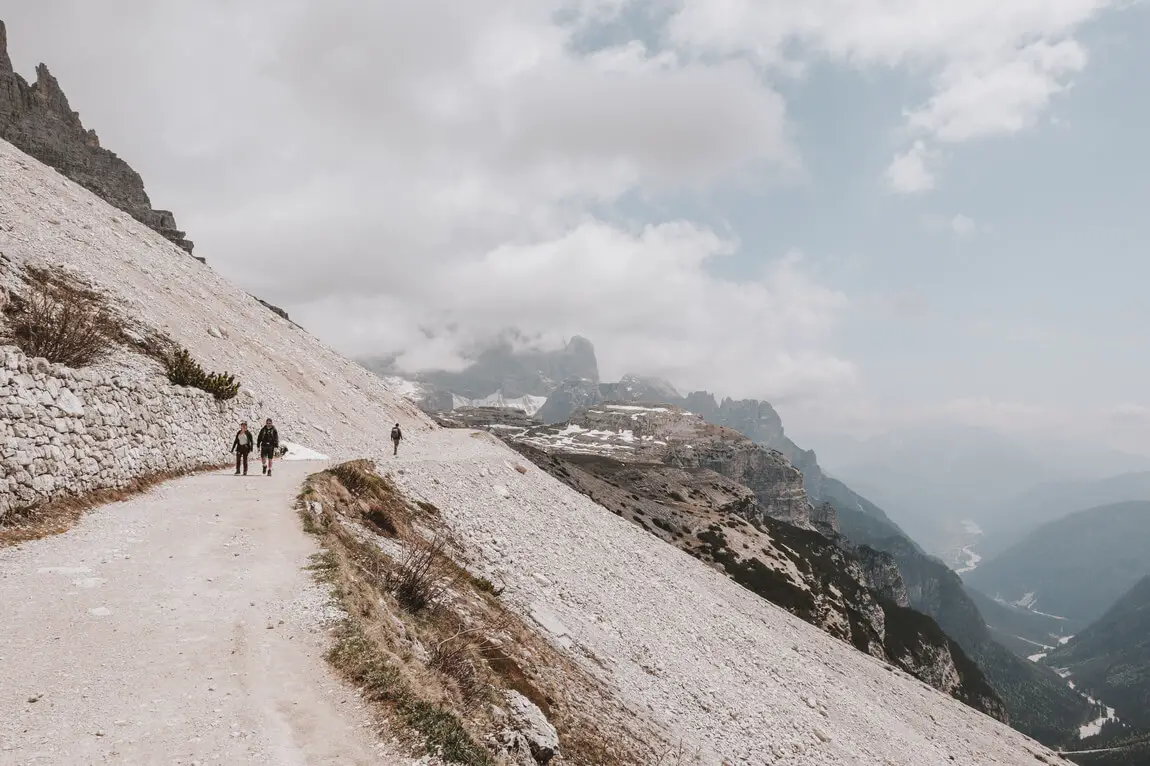
We made a promise to return during a time when the trail is snow-free, ideally in August or September, when the conditions are perfect for hiking.
With that in mind, I recommend adding this point to your Dolomites itinerary only if you have the proper experience and snow gear or are visiting during the summer months when the snow has completely melted. This way, you can fully enjoy the trail to Tre Cime di Lavaredo without unexpected challenges!
» Lake Landro
Next on this itinerary of the Dolomites is Lake Landro. Accessing the lake is incredibly easy, as it’s located right along the road that passes through it. Simply park your car nearby and take a short walk—just a few metres—to reach its serene shores.
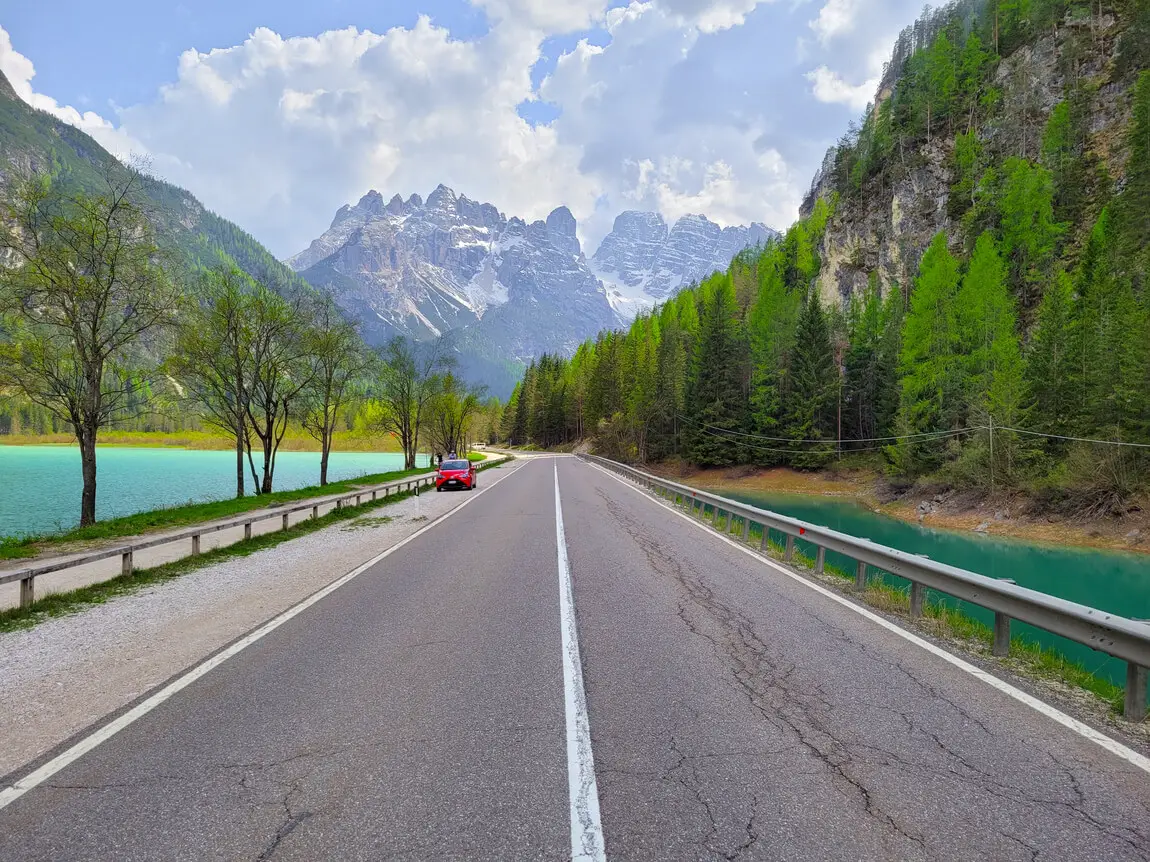
There isn’t much hype about this lake in the Dolomites and I’m not sure how it’s possible because it’s beautiful! The colours of this lake easily compete with Lake Carezza or Lake Braies.
On the way between Lake Antorno and Lake Landro, there is a viewpoint over Tre Cime by the side of the road.

» Lake Dobbiaco
We continue this Dolomites itinerary to Lake Dobbiaco. A very serene lake, with the possibility of walking along its shores.


Access to the lake is also quite simple as the car park is situated right next to the lake. However, you have to pay for the car park.
💡 EXTRA TIP: If you have the opportunity, don’t forget to take a walk around the village of Dobbiaco, it’s really cute 😊.


Restaurants in this area of the Dolomites
I ended up having dinner one of the days in a typical restaurant in Dobbiaco and it was great. The Schlosskeller Toblach has an intimate space and what I liked most was the tagliatelle with ragu and the apple strudel for dessert.



» Lake Braies
And, of course, I saved the best for last—Lake Braies, a place that truly needs no introduction. Thanks to social media, it has become one of the most famous lakes in the world.
My expectations were sky-high, and honestly, it lived up to every single one of them! The lake is just as breathtaking in real life as it appears in the photos 🥰. It’s an absolute must-visit and the perfect way to end this incredible Dolomites itinerary.
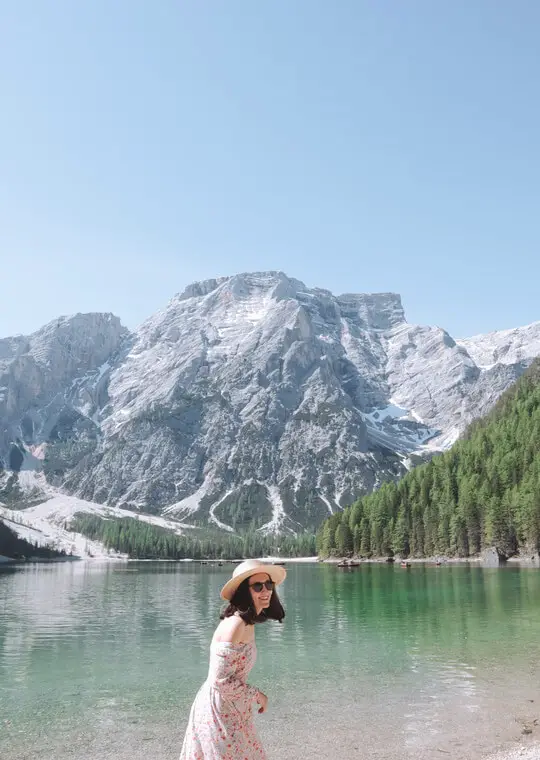

I had the chance to visit Lake Braies twice: once at the end of the 4th day when it was overcast, and again the next morning when the sun was shining. Let me tell you, with the sunlight reflecting off its turquoise waters, it’s even more stunning!
If you’re visiting during the warmer months, you can make your experience even more special by renting a boat. Prices start at 19€ for 30 minutes or 29€ for an hour. This will allow you to glide across the lake and soak in the breathtaking surroundings from a unique perspective.
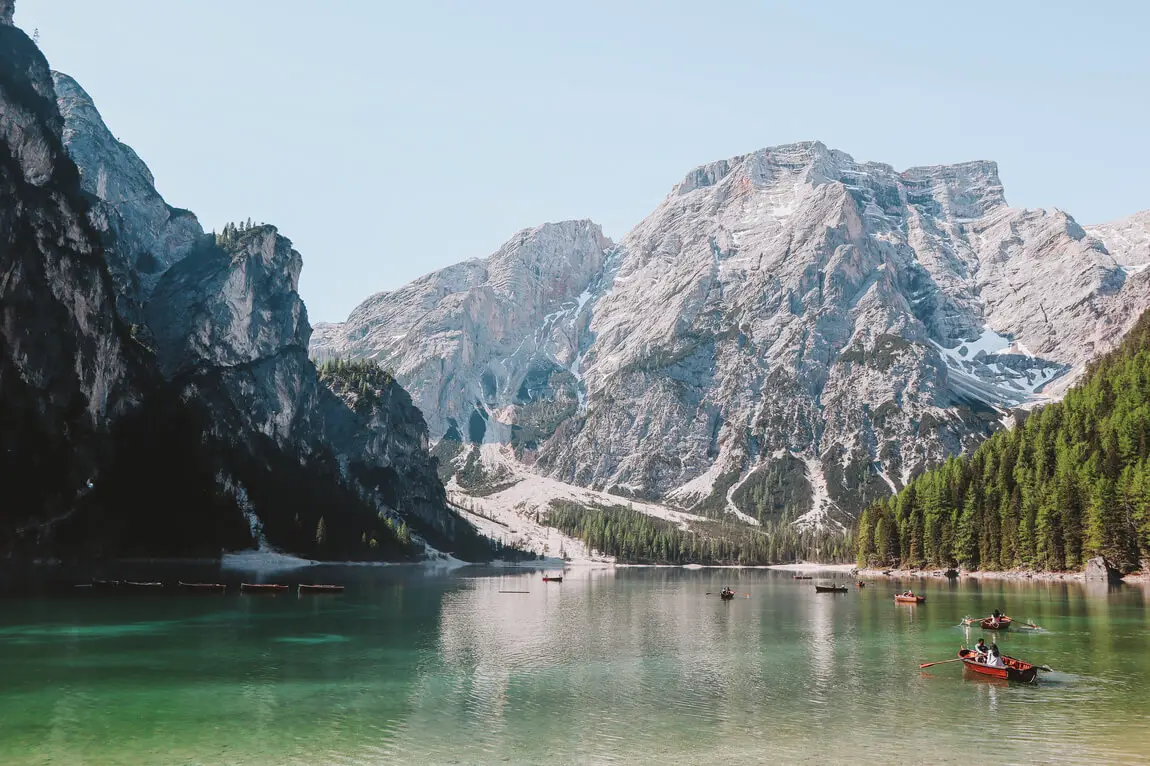
Additionally, there’s also a lovely trail that circles Lake Braies, stretching about 4km. Of course, if hiking isn’t your thing, you can always opt to simply visit the lake, soak in the views, and enjoy its serene atmosphere—it’s just as magical!
🚗 WHERE TO PARK ON LAKE BRAIES: Lake Braies offers several parking options, but during peak season, they fill up quickly due to high demand. Plus, parking is quite expensive here. During high season (usually from July to September), the road is usually closed to private vehicles (except if you make a reservation). Find out more about the traffic and parking regulations at Lago di Braies.
Restaurants in Braies
I had one of the best meals on this trip near Lago di Braies. We went to the Gasthof Albergo Dolomiten and tried the pork loin with roast potatoes and the ravioli with ricotta and spinach. Everything was VERY GOOD!



I have more days available. What can I add to this Dolomites itinerary?
And to finish my recommendations, if you are lucky enough to go more than 4 days to the Dolomites, here are some suggestions to add to your itinerary:
- Lake Sorapis: One of the most beautiful lakes in the Dolomites requires a bit more effort to reach, as it involves walking a trail that takes approximately 5 hours.
- Seceda: beautiful mountain area, but only accessible by cable car (not all year round) or by footpath
- Lake Limides
- Passo Giau
- Lake Federa
I remind you that these are just a few ideas as the Dolomites are a true paradise for nature and trail lovers. I’m sure if you do a deeper search you will find many more amazing places to add to this itinerary 😉.
Final Thoughts on the Dolomites
The Dolomites are a truly unforgettable destination, offering some of the most breathtaking landscapes in the world. From serene alpine lakes to dramatic mountain passes, this Dolomites itinerary is designed to help you explore the very best this stunning region has to offer.
Whether you’re captivated by the charm of small villages, the thrill of scenic hikes, or the beauty of iconic spots like Lake Braies, every stop on this trip is sure to leave a lasting impression.
I hope this guide to the Dolomites proves useful as you plan your adventure. Remember to plan ahead by considering the best time of year to visit, book your accommodations in advance, and be prepared for the unique challenges of exploring a mountainous region.
Have you already been to the Dolomites, or are you planning your first visit? I’d love to hear your thoughts, questions, or favourite memories! Share them in the comments below and let’s keep the travel inspiration going! 😊
Disclaimer: this post may contain some affiliate links, which means I get a small commission if you buy something through my links. This doesn’t represent any additional cost to you and you’ll be supporting my work here on the blog😊







I loved your itinerary and I intend to used it as a reference for my trip. Thanks for sharing all of these details. I also loved all of your photos. Would you mind telling me if it’s a professional camera/equipment or if it’s something more accessible.
Thanks! 🙏🇧🇷
Hi Marco,
And thank you so much for your positive feedback 🙂 It’s difficult to have bad photos in the Dolomites.. it’s so pretty!
Some photos were taken with my phone (Samsung S20 FE) but mostly with my camera (Canon M50 Mark II). I hope this helps 🙂
Happy travels,
Mariana